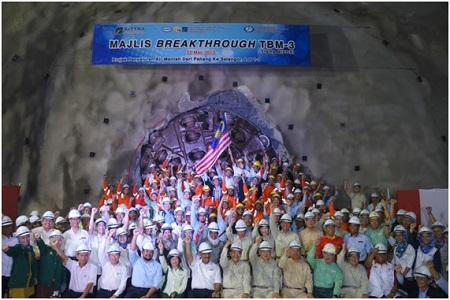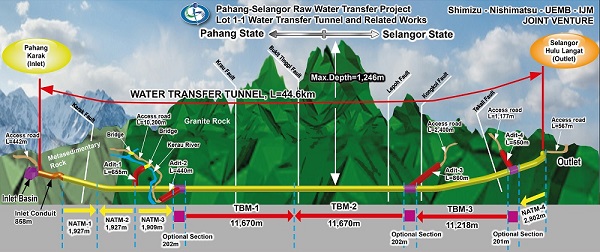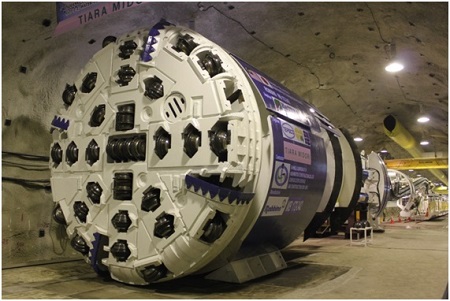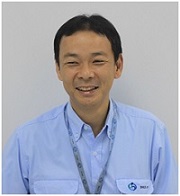IAC News
IAC News Extra.8, February 18,2015
Japan Society of Civil Engineers International Activities Center Feb. 18, 2015
 Pahang Selangor raw water transfer tunnel Project |
Pahang Selangor Raw Water Transfer Tunnel, the Longest Tunnel in Southeast Asia
◆On the Way to Becoming an Economically Developed Country
In the 1980s a project was formulated to bring water from the nearby Pahang State which has plentiful water resources to the western part of the Malaysian peninsula through the Titiwangsa Mountains. The current scheme is to supply 1.89 million ㎥of domestic and industrial water per day to the greater Kuala Lumpur area. By using a tunnel with a gentle slope (1:1,900) passing through the mountains which are over 1,500 m above sea level, it is unnecessary to use pumping facilities to deliver the water, thereby enabling an environmentally friendly and economical scheme.
The target for Malaysia to become an economically developed country by the year 2020 was introduced in "Vision 2020" in 1991, and infrastructure such as a Metro, etc., is being actively developed in the capital Kuala Lumpur and the adjacent state Selangor, an area collectively known as the Klang Valley.
|
The population of this area is currently about 5.7 million, increasing at the annual rate of 2%, and is predicted to be about 8 million by 2020. The water resources of the 5 rivers flowing through this region have all been developed, so providing water resources for the increase in population is one of the issues facing the development of the Klang Valley greater metropolitan area in Malaysia. |
 |
◆Pahang Selangor Raw Water Transfer Tunnel Project
This project is financed with a yen loan from JICA, and orders were placed in 2009 for 4 construction sections: the water transfer tunnel, the dam, pump stations, and installation of steel water pipes. The contract for the construction of the water transfer tunnel was won by a joint venture of Shimizu Corporation, Nishimatsu Construction Co., Ltd., UEMB, and IJM (UEMB and IJM are major Malaysian general contractors). The total length of the tunnel is 44.6 km, the longest in Southeast Asia and 11th longest in the world, and the tunnel cover of 1,246 m is the 8th largest in the world.
Four adits were provided for construction of the water transfer tunnel, so the tunnel was divided into 8 sections, constructed by the cut and cover method, the NATM method, or the tunnel boring (TBM) method. There were 4 sections constructed by the NATM method, each with a length of about 2 km, and this method was adopted in sections where the rock was comparatively weathered granite and sedimentary rocks with a cover of several hundred meters. The TBM sections exceeded 11 km length each, and this method was adopted in comparatively stable granite rock where the cover was large and the uniaxial compressive strength of the rock exceeded 150 MPa. The length of tunnel with more than 1,000 m of cover was about 6 km, and the maximum cover was 1,246 m.
 Figure 1 Pahang Selangor raw water transfer tunnel |
◆High Speed Construction in Long Length Tunnel
The contractual requirement was for high speed construction of 130 m per month in NATM sections and 450 m per month in TBM sections. To achieve this the latest construction machinery was introduced. In the NATM sections computer-controlled jumbo drills were adopted, and in the TBM sections TBMs with a propulsion power and rotational speed 30% greater than machines normally used in this type of rock were adopted. The total length of TBM including backup trailer was 205 m with a total mass of 420 tons. The following Japanese technologies were applied in the TBM construction.
1) Fiber mortar spraying with the TBM method
2) TBM machine control, data monitoring and control system

In the NATM sections, tunneling proceeded with a target average progress of 130 m per month. The average for the 4 sections was 119 m per month, but for the 3 sections apart from NATM-1 where the rock conditions were worse than expected, the average progress was 132 m per month, which was substantially in accordance with the target. Also, a new Japanese record for blasting of 283 m per month was achieved in August 2010.
In the TBM sections tunneling proceeded with a target average progress of 450 m per month. The actual progress was a monthly average of 368 m per month, which did not reach the target, and the maximum progress was 657 m per month. The water seepage which was expected as a risk associated with the large cover, the high rock temperatures, and the occurrence of rock bursts were greater than initially anticipated, and these adversely affected the progress. The maximum quantity of water seepage reached 24.6 tons per minute for the whole tunnel due to the TBM-1 section, but it was possible to avoid inundation of the tunnel as a result of prior water discharge preparations. In the TBM-2 section where the rock temperature exceeded 55 degrees the ventilation equipment was expanded, and cooling equipment in the working areas was expanded so that on 19th February 2014 excavation of the 44.6 km of water transfer tunnel was completed. As of January 2015 lining by spraying is continuing, aiming for completion of construction in March.
As for my personal impressions, when I first heard about this project to be honest I felt that it was a dream project. I wondered whether it was really possible to construct a 44.6 km tunnel, which is rare either overseas (Malaysia) or in Japan, by a single JV, and moreover in the short construction time of 5 years. However as a civil engineer I definitely wanted to participate in the construction of this 44.6 km tunnel. When my superior told me to go to Malaysia I was delighted, and took up the assignment immediately without taking any leave. Recently the number of large scale projects has been increasing in Japan, but overseas there is virtually an unlimited number of large scale projects. I think that to be able to undertake the challenge of these projects is the real thrill of overseas construction.
To date staff and workers have gathered from 12 countries around the world but mainly from Asia, each having the same feeling as me. In terms of equipment, the latest construction machinery was gathered from around the world but mainly Japan, and it functioned well. The progress in the construction to date was due not only to labor and machinery, but also to the Japanese civil engineering technology and site management methods, which functioned extremely well.
 Figure 2 TBM-3 breakthrough ceremony |
Above all, the fact that there has been no major accident since the start of construction until now is due to the efforts of each and every individual involved, and it gives me great satisfaction and pride. I want to continue until completion of construction with zero major accidents.
Finally, examples of construction of long tunnels 44.6 km length with cover of more than 1,000 m, and examples of high speed construction of long tunnels by TBM are extremely few, so it is expected that the knowledge gained through this project can be used in the planning and execution of long tunnels both in Japan and overseas.
 |
Takayuki MATSUMOTO Project site manager of Pahang Selangor Raw Water Transfer Tunnel construction site Shimizu Corporation, International Division Joined Shimizu Corporation in 1994. Has mainly been involved in overseas construction projects. Within Japan he has worked on the Tokyu Toyoko Line track quadruplication project (between Denenchofu and Tamagawaen). International projects he has worked on include Musi underground power station (Indonesia), Beris Dam (Malaysia), Delhi Metro Phase I (India), New Bangkok Airport access road (Thailand), Punggol Reservoir (Singapore), etc. He has been engaged on the Pahang Selangor Raw Water Transfer Tunnel since 2009, is in his present post since April 2014. |
◆Editor's postscript
This is the 3rd time that we have featured a project in the International Activities Center Communication Special Edition. The symposium “IAC Japanese Civil Engineers the Global Leaders Symposium Series” is held several times per year by the International Activities Center, and the presenters are always asked to submit a written paper.
The presenters are asked to submit papers voluntarily, and this opportunity to introduce Japan’s outstanding civil engineering technology to the world is positively accepted, and on every occasion the work is willingly undertaken. For this we are very grateful.
The Information Networking Group Leader of the International Activities Center will continue this scheme in the future, so that Japan’s civil engineering technology will become more widely known throughout the world.
